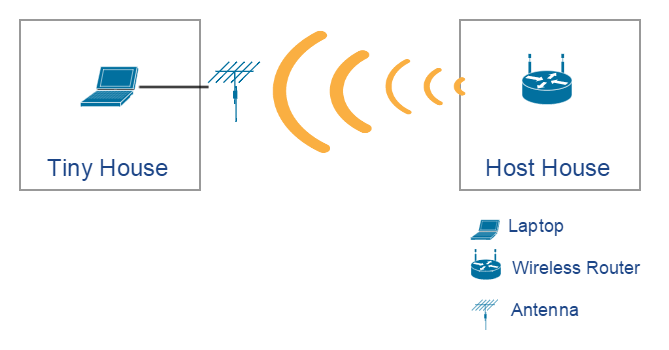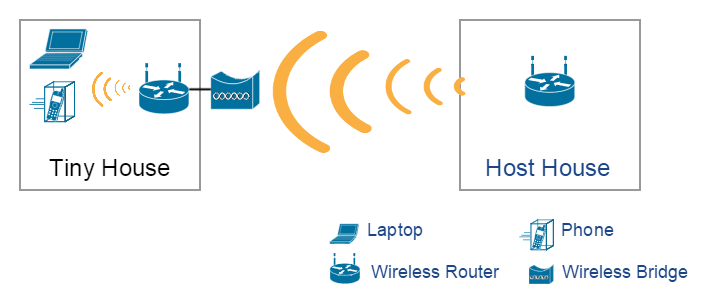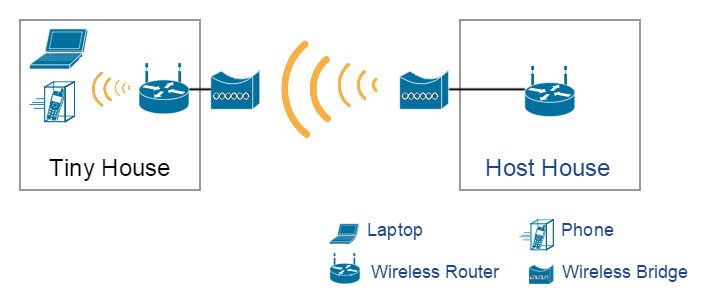In today's connected, online world, having access to the internet is right around as important as having access to water (not really, but you get the idea). So how do you get access to the internet in your tiny house? Or anywhere you need off grid internet? The answer depends on where you are located/parked...
Since a tiny house isn’t on a foundation, it’s hard to request services that are otherwise easy for a conventional homeowner to get. Installing the service wires costs money, but the providers expect to make it up (plus a lot) over the lifetime of you paying for service. On the other hand, they aren’t so keen on running service to an RV or tiny house. Since it’s not a permanent structure, they have less assurances that you will be a long-term subscriber, and thus not as sure you will make it worth their while. So, you will need to get your service from another source.
Get it from Your Nearby Host
If you are parked in someone’s backyard or in their driveway, there’s a good chance that you can just connect to their wireless router just as you would at your local Starbucks or cafe. The significant difference is that they will have a password set that you will need to get from them to connect. At one time most routers came unsecure so that they were easier to set up. But in the last few years there has been more of a shift to security with many routers coming with security features turned on by default and even some routers NOT performing as well or as fast unless they are secured. As a result, you can’t find as many unsecure routers as you used to. So whichever router you want to connect to, you will need to ask its owner for their password. Offering to chip in on the monthly bill might make that conversation a little less awkward. If your host is nearby, the only equipment you will need is your computer/tablet/phone. Do be aware that when you connect to someone else’s router, unless you are connecting through a VPN (Virtual Private Network) or are on a secured site (HTTPS), it is possible, although unlikely, that someone else on that network can see your traffic (what you are looking at).

Get it from Your Not So Nearby Host
If your house is parked on land that is a little more rural, and your host is not as close, then you may find that your computer isn’t within range to connect to their router. In this case, assuming you don’t want to run a cable all the way from their house, you’re going to need some additional equipment. One option is to add a longer-range antenna to your computer. While this option works well, it’s not very convenient. First, the antenna takes up a lot of room unless you mount it somewhere. Second, since laptops don’t often come with antenna connectors you will also need an adapter to hook it up. This results in more wires which makes your computer a little more difficult to move. Finally, the biggest downside is that this only provides internet to the computer with the antenna, and you still won’t have internet on any of your other devices. While there are ways to share this internet connection, it can be a pain.

The image above is an example of an external antenna attached to a network adapter that would then get plugged into a computer with a USB cable. A better option is a setup that includes a device called a bridge. There are many companies out there that offer wireless bridges, but a favorite of ours is Ubiquity. A bridge includes a high gain antenna that allows it to pick up your host's internet signal from much farther away than your other devices can receive. It can also be mounted outside and pointed at your host to extend its range even farther. You then hook up your router to the bridge to create your own network within your house for all your devices to connect to. The bridge can also act as a firewall keeping people from your host network from connecting to your computers.

Above is an example of a external bridge/antenna Finally, if you are so far away that even the bridge can’t connect to your host, you can add another bridge on their end to extend the internet signal so that you can be as far away as 5 miles!

Get it from Your Phone or Hotspot
If you simply don’t have a host you can get internet from, consider using your phone or a hotspot. Many smart phones can be set up so that they can be used as a hotspot, or they sell devices that are dedicated hotspots. What this means is that your hotspot shares its internet connection (provided by the phone company) via Wi-Fi, allowing your computer and other devices to connect. Depending on your signal, the speeds can be great or absolutely make you want to poke your eyes out slowly. Be aware that your phone's service plan has a data cap, meaning that they will only let you transfer a limited amount of data per month. So don’t plan to watch too many movies on Netflix or streaming Pandora. Even if your phone’s service provider says that you don’t have a data cap and are on an ‘unlimited plan’, they will still probably throttle your speed to painful levels once you exceed some threshold.
If you plan to use your phone for internet, you are going to be heavily dependent on your phone’s reception or signal quality. To help with that you may want to consider investing in a cell phone signal booster or amplifier like weBoost.
weBoost is a brand of cell phone signal boosters designed to enhance and amplify weak cellular signals. These boosters work by capturing signals from nearby cell towers and amplifying them for better reception and coverage inside homes, offices, or vehicles. The benefits of a signal booster include fewer dropped calls, faster data speeds, improved voice quality, extended battery life, and better overall cellular connectivity. With a signal booster, users can enjoy improved cellular performance in areas with weak signal strength, such as rural or remote locations, or in homes with metal roofs that interfere with cellular signals.
If you don't plan to travel much, some mobile phone companies are now offering home internet. This is just a hotspot by a different name, but the pricing and data caps may be more favorable.
Get it from a Satellite
The final option I would consider is getting off grid internet from a satellite service provider. There are many companies that offer this service. Here is a great article that compares the two biggest traditional internet satellite providers. It also explains exactly how it works and what equipment you need.
A newcomer to the satellite internet market is Starlink by SpaceX. Since they are new you can't get their service quite everywhere yet, but if you are in their service area, I would highly consider them. They utilize a much denser constellation of smaller satellites that offer much faster service than the other two I reference above. The pricing is always shifting, but at the time this article was published they were competitive.
One thing to note is that just because you are getting internet from a satellite, doesn't mean you can move around the country and still get service. Many companies will charge a premium if you want that flexibility. For instance, Starlink charges an extra $20 a month to connect from various locations. And if you want to connect while on the move on land (don't even ask about the pricing for a yacht or plane), the hardware costs an extra $1900. So be sure to inquire if you plan to use this while travelling.
Do you have a unique or different way of connecting to off grid internet? Share it in the comments below! Happy connecting!